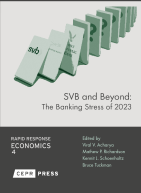The general lessons from the report are the following.
First and foremost, a holistic approach to regulatory policy is needed. Capital, liquidity, accounting, and disclosure requirements should be set together, and their interactions should be considered. The effects of different quantitative monetary policy regimes – quantitative easing (QE) and quantitative tightening (QT) – on financial stability should also be taken into account, besides the effects of conventional or rate-based monetary policy cycles. This comprehensive approach is crucial for the stability of the banking sector.
Second, prudential rules should be applied uniformly to institutions that pose systemic risk, even if they are small individually but not collectively as a ‘herd’ or in the aggregate. Proportionality regimes should not compromise the need to preserve systemic banks’ safety and soundness.
Third, liquidity regulation should be adapted to the changes in the banking market induced by digital technology.
Fourth, liquidity insurance should be priced properly, be it with risk-based premiums for deposit insurance or with collateral pre-positioning for lender of last resort support.
Fifth, early intervention frameworks and resolution planning should be reinforced, and more attention should be paid to the value of market-based signals as supervisory signals for early intervention or investigative escalation.
Finally, a consistent, timely, and complete implementation of global standards across jurisdictions should be given maximum priority.
Boom and bust in uninsured bank deposits and policy response
The banking turmoil of early 2023, initiated by the failure of three mid-sized US banks, highlights systemic vulnerabilities stemming from an over-reliance on uninsured deposits, typically demandable corporate transaction deposits, amidst rapid money and market expansions driven by QE. The subsequent interest rate hikes and reversal of QE triggered a liquidity crisis, which eventually became a solvency crisis. SVB's failure, triggered by a massive exodus of uninsured deposits, illustrates the divergent vulnerabilities within the banking sector to the liquidity risks as well as the domino effect within the banking sector, emphasising the fragility across institutions, especially smaller and medium-sized ones. The 2023 banking stress also underscored the amplifying effect of digital finance on the speed of withdrawals and contagion risk.
This crisis underscores the need to reassess regulatory frameworks, supervision tools, and monetary policy to mitigate similar vulnerabilities in the future. Policy responses should balance containment of spillovers from runs through improved deposit insurance (for which the Federal Deposit Insurance Corporation, or FDIC has made various propositions in the US) and lender-of-last-resort support, with decreasing their incidence through stricter capital and liquidity requirements, which should apply consistently across banks. Ex-ante prudential measures, such as capital and liquidity requirements, must be reviewed to check whether they account in a timely manner for interest rate risk, bank liability structure, and information from market values being reflected in supervisory procedures. Stress tests must comprehensively incorporate interest rate risk and the effects of higher-than-usual interest rates, not just for large but also for mid-size and smaller banks. In any case, it is also necessary to address the liquidity risk of non-bank financial intermediaries (NBFIs). Adding collateral pre-positioning to the toolbox of liquidity regulation as a pre-condition to obtain liquidity support from the central bank should be considered. A comprehensive solution such as the ‘pawnbroker for all seasons’ (PFAS) proposal aims to mitigate fragility by requiring banks and NBFIs to collateralise short-term liabilities. Still, it faces implementation hurdles and represents a significant departure from the current policy that needs careful scrutiny since it will affect banks' ability to intermediate financial flows in the economy.
Overall, the crisis underscores the imperative for proactive measures to safeguard financial stability from the boom-and-bust pattern in uninsured deposits amplified by digital banking, mitigate systemic risks within the banking sector, and recognize potential interactions of financial stability with monetary policy.
Prudential regulation, accounting, and supervision
The banking turmoil was the first significant test of the Basel III framework. While it proved its adequacy in general terms, there is clearly room for improvement. Failures and rescues were not due to regulatory design flaws entirely but at least in part to weak implementation of global standards and their suboptimal implementation and supervision, with accounting standards playing a critical role. SVB and Credit Suisse had faulty business models with poor risk management and governance. SVB was exempted from liquidity regulation. In both cases, capital was overestimated. In the SVB case, this was due to the ‘accumulated other comprehensive income’ (AOCI) filter which allowed regulatory capital not to reflect losses on the securities book, and in the Credit Suisse case, the filter used to evaluate subsidiaries also played a role. Sometimes supervisors knew the problems but were slow to react, or authorities higher up did not react with alacrity when supervisory flags were raised.
The crisis underscored the interplay between prudential regulation and accounting standards, particularly regarding the classification of investment in debt securities and their impact on regulatory capital. The recommendation is that the AOCI filter should be removed and that the bank-specific Pillar 2 requirement for interest rate risk on the banking book (IRRBB) should be applied more consistently, possibly incorporating an IRRBB in the Pillar 1 minimum capital requirements. Concerning the liquidity coverage ratio (LCR), the deposit run-off rates should be increased due to the prevalence of digital banking coupled with the impact of social media. The LCR time horizon should be rethought, and a Pillar 2 High Quality Liquid Assets add-on should be included depending on the level and the speed of ‘run’ risk in the bank's liability structure. The aim is to reinforce the LCR and give supervisors time in a crisis. We discuss possible reform options in the direction of mark-to-market measurements, such as improving the disclosure requirements for the (unrealised) losses deriving from held-to-maturity (HTM) securities, a ‘mark-to-maturity’ approach to HTM securities, facilitating hedge accounting, and considering market signals such as stock prices or analyst forecasts for supervisors.
These lessons for regulation highlight the need for disciplined and consistent approaches, especially regarding interest rate risk and liquidity regulation, to ensure a more effective treatment of systemic risks across jurisdictions. Regarding supervision, these lessons are based on a recognition that the banking crisis of 2023 exposed gaps in early intervention frameworks and enforcement capabilities, emphasising the importance of timely action and comprehensive risk management assessments. Enhanced governance quality, risk management systems, and broader risk indicators are therefore essential for more responsive and effective supervision.
lessons for bank failure management
The Global Financial Crisis catalysed a pivotal shift in banking policy reform, which led to the creation of a new bank resolution framework. This transformation was driven by the commitment of the Financial Stability Board (FSB) to mitigate the systemic impact of bank failures with the bail-in tool, which empowers authorities to intervene by writing down liabilities or converting them into equity, thereby absorbing losses without resorting to public funds. Yet, implementation remains uneven across FSB jurisdictions, with approximately only half fully integrating the bail-in tool, underscoring a significant gap between policy intent and execution. Furthermore, failures in 2023 were resolved outside the revised resolution regimes, even though they included Credit Suisse, a global systemically important bank, and all cases, including the mid-size bank failures in the US, had a systemic impact.
The turmoil underscores the need for regulatory reforms to create more effective and flexible resolution tools and external support when needed. In particular, resolution plans should contain possible combinations of resolution tools (such as sale-of-business and creditors’ bail-in) rather than focusing on a single resolution strategy. The need for credible and timely public backstops for liquidity support in resolution should be recognised. Working together, such backstops and resolution frameworks can reduce the need to provide blanket bailouts to failing banks. Bank crises highlighted flaws in the failure management regime as well as in adequacy of regulatory capital measurement. They pointed to the need to extend resolution planning to all banks that may affect the financial system, including a minimum amount of loss-absorbing liabilities in resolution (preferably with long-term debt instruments), adequately tailored to facilitate the chosen resolution strategy and to reconsider the eligibility of Additional Tier 1 instruments, as currently designed, as regulatory capital.
The Crisis Management and Deposit Insurance proposal marks a significant improvement in the EU by expanding the resolution scope and facilitating the required funding for the management of the failure of mid-sized banks. Still, there is room to improve the calibration of Minimum Requirement for own funds and Eligible Liabilities (MREL) for sale-of-business strategies, as well as the provision of liquidity in resolution and of extraordinary external support in extreme circumstances. The overall aim of the reforms should be to strengthen the resolution framework's efficacy to reduce the need for government bailouts, and introduce the required flexibility to adapt to unexpected challenges in the resolution processes to preserve financial stability. Last but not least, these reforms do not alleviate but rather strengthen the need to complete the European Banking Union.
References
Acharya, V, E Carletti, F Restoy and X Vives (2024), Banking Turmoil and Regulatory Reform, The Future of Banking 6, CEPR Press.
Bolton, P, S Cecchetti, J P Danthine, and X Vives (2019), Sound at Last? Assessing a Decade of Financial Regulation, The Future of Banking 1, CEPR Press.
Carletti, E, S Claessens, A Fatas, and X Vives (2020), The Bank Business Model in the post-Covid-19 World, The Future of Banking 2, CEPR Press.
Duffie, D, T Foucault, L Veldkamp, and X Vives (2022), Technology and finance, The Future of Banking 4, CEPR Press.







